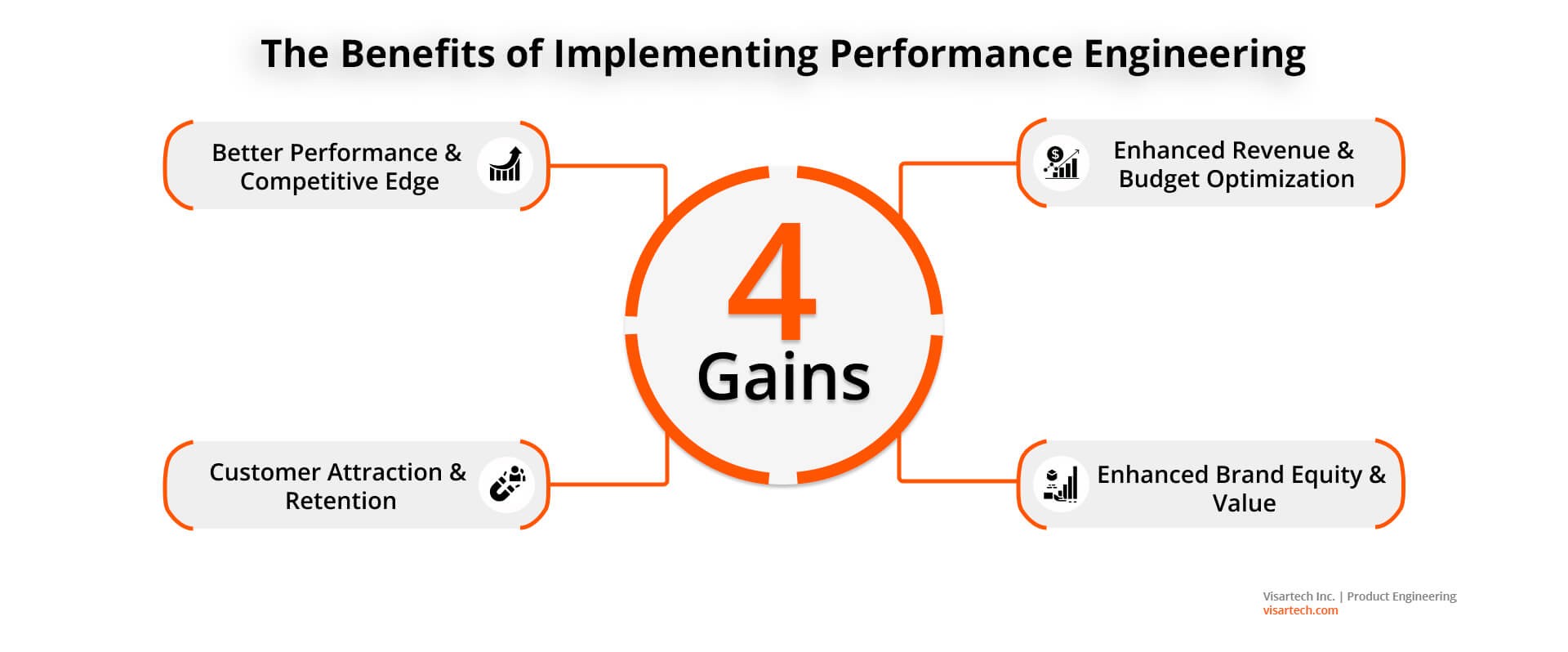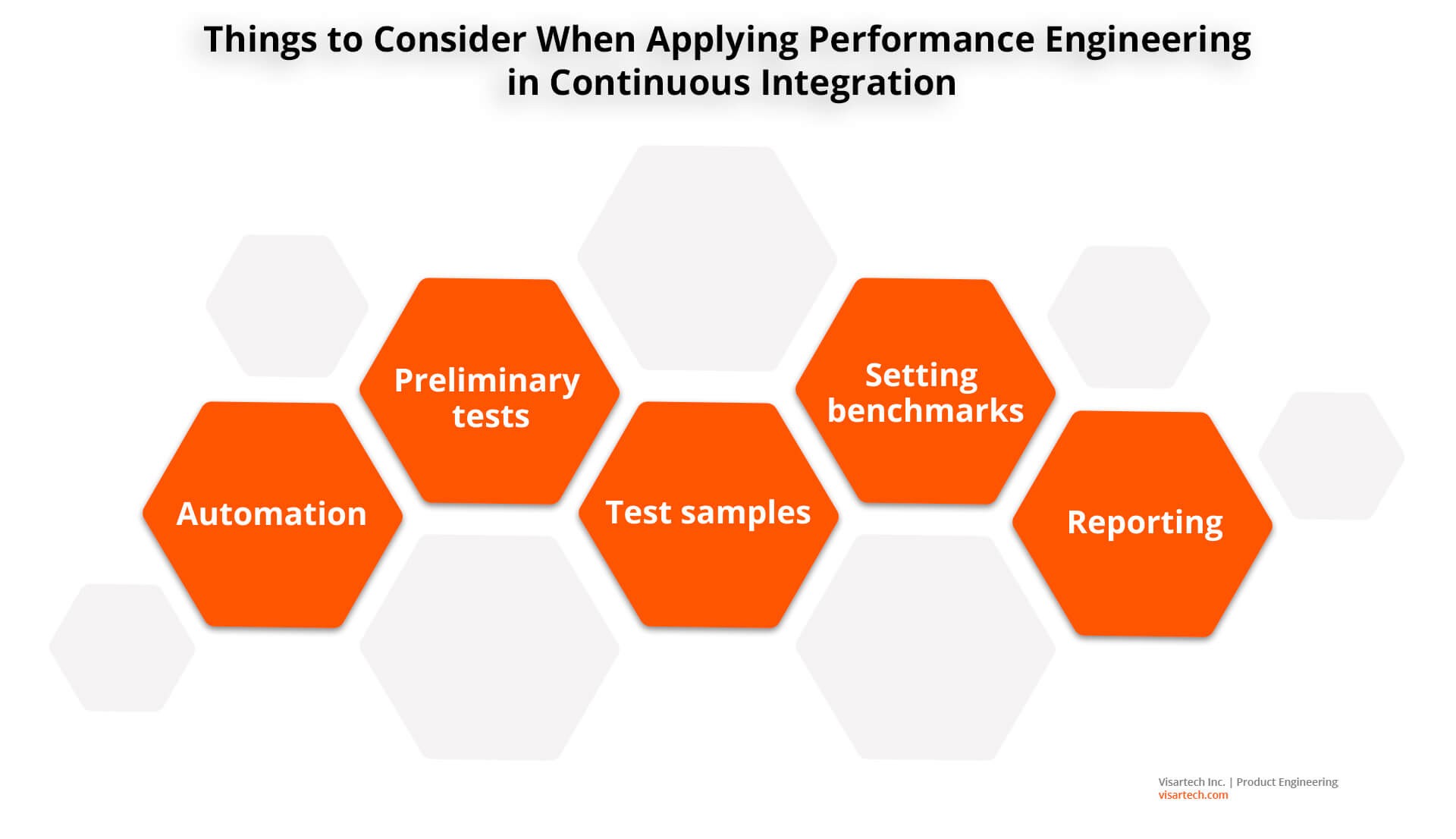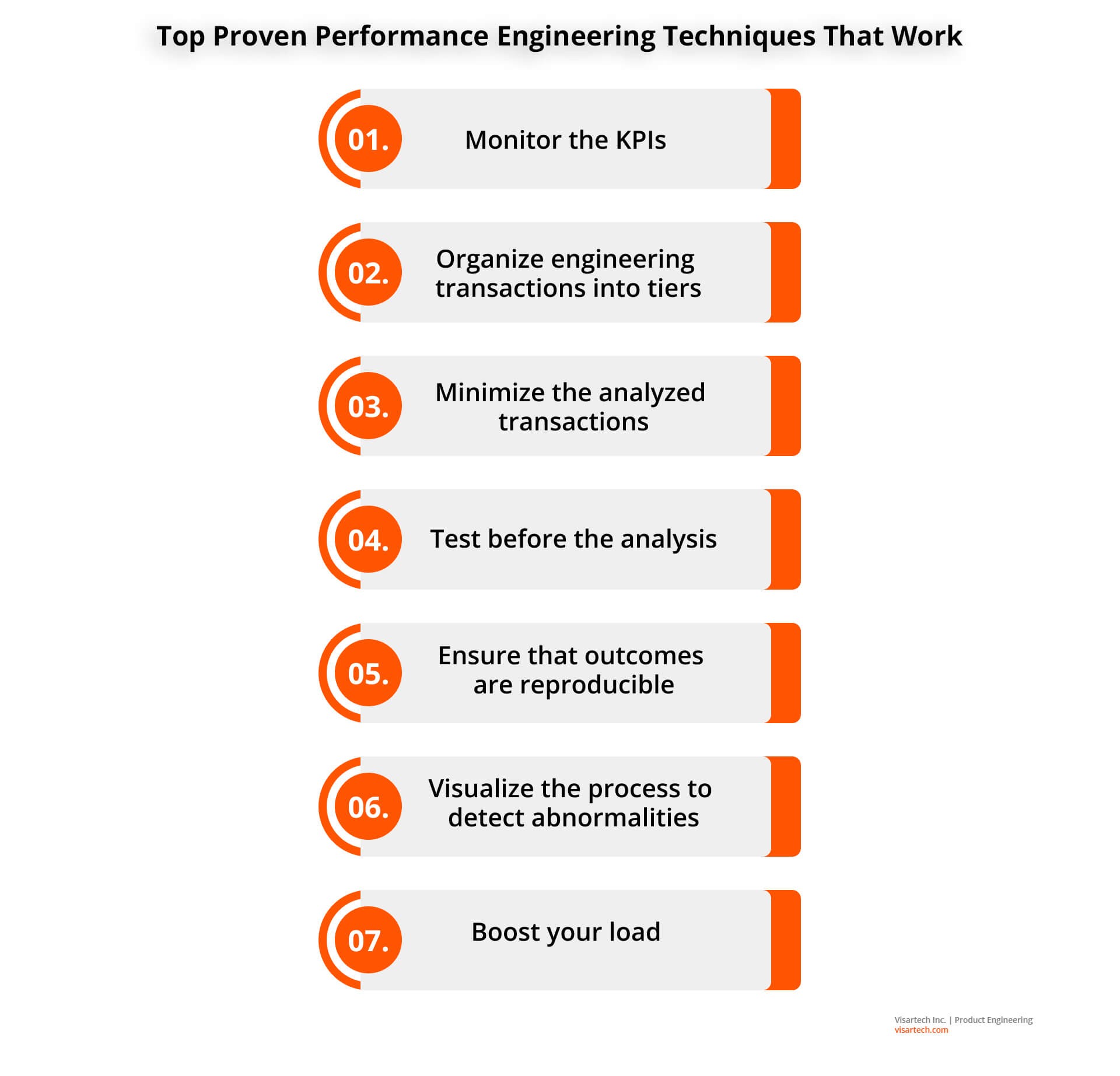In a world of increasing software quality standards and customer expectations, performance engineering gives organizations a head start in the market. Building a solution with quality in mind not only improves its performance but also helps build a strong reputation and loyal customer base in the long run.
To put it briefly, performance engineering helps to ensure that the software solution is all set for deployment and meets all non-functional requirements. Read on to learn what performance engineering is in more detail, and why businesses should care.
What is Performance Engineering?
Say you are building loan management software, a social network application, or a B2B education platform and you want to make sure that it runs smoothly under different circumstances. This process is called performance engineering. It’s an umbrella term for different methods, technologies, and people that are all engaged throughout a software development life cycle to verify compliance with the performance criteria.
In performance engineering, a set of different tests is applied to eliminate bottlenecks. It helps to see how the software performs in specific scenarios that are most likely to occur in post-production.
During the project lifecycle, software performance engineering is closely intertwined with the architectural design to detect performance and stability issues. This makes performance engineering a viable method for getting things done right on the first try and creating a software solution that brings value to customers.
Performance Engineering vs. Performance Testing
Performance engineering and performance testing are often used interchangeably. Though similar on paper, they’re different in practice. That’s because performance engineering takes a far larger and more holistic view of software performance throughout its lifespan. A performance engineer observes and examines the software to detect performance gaps, and also provides a solution to fix them.
Then, what is performance testing in software engineering? It’s part of performance engineering that identifies bugs and abnormalities by executing certain processes and steps. Yet, performance testing doesn’t define the root of the issue. It evaluates how the software functions in different scenarios and according to the criteria.
A performance tester can also determine the software’s performance limits and thus foresee and prevent crashes. However, performance testing itself has little potential to pinpoint the cause of poor performance. A system performance engineer comes to the rescue, identifying and eliminating this cause.
Performance engineering plays a vital role in software development and requires profound expertise. It helps to understand what areas need work and suggests ways to improve the performance of the software solution in the design phase.
We can look at software performance engineers as an upgraded, elevated role of the performance testers. In essence, a software performance engineer simulates the situation to test how the software will behave before entering the market. That is, to minimize unwanted performance surprises.
The goal here is to collect the right data to fully comprehend how the software works and behaves on a technological level. Coaching is another aspect of performance engineering. You become part of the delivery team and educate them on the possible performance risks, testing techniques, and coding standards, and ultimately help them create high-performing software.
In performance testing, the main objective is to build test suites and assets. That is some sort of framework, which checks software performance under given conditions. The testing stage makes the engineering part even more valuable to the entire software development lifecycle process. There’s more to it than just performance.
As you can see, there’s a huge difference between these two concepts. You may know how to use the tool, run the test, and generate results. But ultimately, performance engineering is about knowing why you are doing what you doing. It’s about adding real value to the solution.
Why You Need Performance Engineering
Modern businesses must learn to adopt new methods that improve performance and quality throughout the organization. This became possible with the introduction of advanced software performance engineering methods, which are used to improve non-functional requirements, usability, security, technical management, third-party services, the cloud, etc.
Read also: Security Testing and Top 10 Software Vulnerabilities
Find out how to make the software more secure
Who runs this process? The main stakeholders in performance engineering cover the full range, including Business, Development, Operations, Testing/Quality Assurance (QA), and end-users. The entire team takes full responsibility for training, investigating, and diagnosing performance issues, as well as providing the solutions.
Speaking of QA, it must not be confused with quality engineering. If your development team is serious about enhancing software quality, it should examine the quality engineering vs quality assurance discussion.
Read also: Behind the Scenes of Development Process: The Visartech Workflow
Learn the methods of organizing effective workflow that we apply at Visartech
To put it briefly, you can think of quality engineering as a set of processes and mechanisms that aim to integrate quality throughout the solution lifecycle. Quality assurance engineering, conversely, is part of quality engineering based on sophisticated testing methods used to develop stable and functional software.
Back to the topic. Software performance engineering techniques enable firms to achieve the following target areas and business goals throughout the product development life cycle:
Competitive Edge
With an effective performance engineering strategy, you have the ability to exceed your end users’ expectations and establish a robust brand image.
All this gives a competitive advantage to providers within the technology chain and urges the need for creating a new performance-focused corporate culture. Why is this so?
When you focus on performance and design the core business strategies, you can estimate both internal and external user experience. This gives you an edge in delivering the most streamlined software and hardware experience demonstrating fantastic performance.
Read also: 10 Reasons to Write Tech Specification
Learn what it is and why it’s important
Therefore, performance must be prioritized from the start of the process and closely monitored once the code has been deployed. As a result, faster software gives you less frustrated teams and more satisfied consumers.
Customers
If you know your customers well, most of the work toward success is done.
Developing strong performance engineering strategies and practices for rapid improvement can change the entire course of your business. Focusing on software performance is a customer-centric approach, which is beneficial for both attracting new clients and keeping existing ones.
Even in the tech environment, customer satisfaction is worth its weight in gold, although it impacts your business indirectly. Clients are hungry for easy and scalable solutions to complex, tech-related problems. Thus, the performance of your software solution decides whether they stay with you or leave, moving on to the next supplier.
Revenue
Revenue is often a tell-tale sign of changes within the organization. Businesses may boost revenue and cut costs, like in web application development, by using effective performance engineering techniques, which we’ll cover shortly. They help them reduce hardware acquisition expenses and other costs by transforming the end-user experience.
By building in performance, companies can optimize their software before the code is written and, thus, minimize performance-related production failures. As such, they can apply fewer resources to support the infrastructure and handle more transactions.
This is how performance engineering techniques allow businesses to accumulate savings and invest in a valuable talent pool for new features and functions development for the end user. That is, it helps focus on core business needs.
Brand Equity & Value
Both brand value and brand equity are associated with a brand’s worth, but they do so from two different viewpoints: the market value of the brand and how its customers perceive it. However, as we see the performance engineering practices in action, this is becoming increasingly relevant to all stakeholders, and for good reason.
Tackling the subtleties of system performance design protects your business from large-scale disruptions and small problems like. For example, team dissatisfaction or customer churn.
Poor performance may impair brand loyalty and value. So it makes sense that both systems’ performance and the company’s success impact the brand as more people interact with it via online and mobile channels.
By focusing on performance engineering, companies can boost revenue, customer acquisition and retention, brand value, and competitive advantage, all while meeting and surpassing end-user expectations.
Agile Principles for Performance Evaluation
In today’s fast-paced business landscape, many projects utilize agile principles to deliver products. The key reason for this is the superior quality standards of the finished solution. Also, many agile principles can be applied in performance engineering.
Let’s see what these concepts are!
- 360-degree feedback;
- Regular and continuous testing;
- Align individual goals with corporate ones;
- Build a robust skills roadmap.
Through the software development life cycle, the likelihood of system errors and mistakes can be significantly decreased with the help of agile strategies in performance engineering. However, customer satisfaction remains the main pillar of the agile approach.
Among other benefits, the team may see performance improvements by implementing continuous testing, coherent teamwork, and knowing each sprint’s duties. Hence, by completing the small tasks following agile principles, one can gradually head towards large-scale achievements.
Last but not least, your company’s morale is defined by the ability to comply with these agile principles and can potentially motivate your team to do a better job and improve the quality of work.
Performance in Continuous Integration
Software products are consistently developing, which means that more and more features get added. At the same time, the development speed increases as well.
Continuous integration (CI) is designed to help ensure that new code merges with the core codebase. CI typically entails automated testing and requires developers to check their code changes regularly. The majority of testing solutions extend CI systems to offer performance trends and feedback following the creation of each build, such as Jenkins and Bamboo.
Read also: Trunk Based Development in Continuous Integration
Discover the benefits of being in real-time sync
Continuous integration guarantees that production changes are delivered more quickly. However, we still need to make sure that these improvements operate as expected. That’s why you need to integrate performance engineering into the CI pipeline.
One aspect of the continuous integration process is performance testing. To ensure that your software can handle traffic, users, and data transfers appropriately, apply stress testing. It is important to measure both machine stress and system performance.
To guarantee performance and stability, performance testing must be treated as an integral element of a CI paradigm.
There are certain rules to blend together performance engineering and CI effectively:
- Automation. By automating the load testing procedure, testing will be performed directly within the CI framework. This will prevent you from launching a low-quality development.
- Preliminary tests. Conducting tests at the final stage of the CI pipeline isn’t particularly logical, and it only adds more work for the team. So, continuous testing should be done from the very beginning, and you may even run it concurrently with automated unit tests.
- Test samples. It’s for the best if you start testing your software in the most complex parts. However, it’s not necessary to fully test the product in its early phases of development, you can go for the small pieces of it.
- Setting benchmarks. You need to establish certain criteria to compare the indicators in the future for correct automation. Awareness of performance minimums and starting points is a must.
- Reporting. An essential component of software development improvement is providing regular, thorough reports. With continuous reporting throughout the project, tracking compliance, performance, and server load is eventually simplified. Plus, vulnerabilities can be detected early thanks to obligatory reports.
Performance Engineering Best Practices
The quality of your end solution is much dependent on the effectiveness of the performance engineering strategy that you choose. The right engineering performance objectives establish crucial connections within the team by helping understand what tools and techniques work best.
A software performance engineer understands that concentrating just on the task of moving fast is insufficient. Speed engineering is beside the point here. The difficult part is determining how the software benefits the organization, its personnel, and its consumers. If they succeed, the software will be a success as well.
Therefore, the best practices in performance engineering can be split among the teams. Some of these, however, are listed below as being the most crucial:
- Make the most of caching: The selection of the appropriate caching mechanism is critical to the product’s proper operation.
- Keep the requests to the server to a minimum: This practice is a time-saver and efficiency booster when it comes to performing operations.
- Take care of the memory, which is also applicable to network connections and database calls.
- Try mastering asynchronous processing, a viable strategy to reduce the workload.
- Don’t disregard performance auditing, which is an important technique to avoid unexpected disruptions and accelerate the workflow.
All in all, performance engineering is a tried-and-true method of enhancing your end solution’s performance and making it easier to succeed in the highly-competitive market.
Practices for Architecture & Design
- Create performance-centered culture;
- Specify your performance budget;
- Determine the components;
- Set your acceptance criteria;
- Prepare for deviations from the norm;
- Prototype and test.
Practices for Development Testing
- Integrate performance into your build validation tests (BVT) and collect data after each build;
- Make your UNIT tests more performance-oriented;
- Automate quality gates during the build process to prevent reusing subpar components;
- Deploy a branching technique to not let the parts break the code or cause its poor performance;
- Follow the outcomes of systems and components to see how they change over time.
Practices for Operations
- Ensure that disaster recovery, capacity planning, and resiliency are of the highest priority;
- From pre-production through production settings, deliver continuous deployment and operations;
- Create a production environment using the following deployment methods: canary, live/live, or blue/green;
- Establish a system for predictive and scaled growth, as well as tracking features and configurations, and providing ongoing feedback;
- Maintain an all-encompassing monitoring approach that includes comprehensive and ongoing feedback in all contexts;
- Know your most used features and functionalities across the stack and lifecycle;
- Define your hot spots (e.g., software, hardware, configurations, etc.);
- Create a procedure for reviewing production incidents that focuses on learning and long-term stability.
Top 7 Performance Engineering Techniques That Work
As you can see, an effective performance engineering strategy goes beyond the speed of the process or cost-saving goals. And even performance isn’t the ultimate goal in this process.
A competent software performance engineer knows that his job is to change the perception of software and hardware systems as we know them. The goal here is to develop new, sophisticated architectures and designs of the solution and, thus, improve the end user’s experience.
Businesses, on the other hand, can gain a high-performing and robust capacity to maintain the development of their products and services.
Moreover, there are large volumes of data to deal with and analyze in performance testing.
Here’s a list of some proven performance engineering techniques that might work for your business:
- Monitor the KPIs;
- Organize engineering transactions into tiers (web, app, and database);
- Minimize the transactions that you analyze;
- Testing before the analysis;
- Ensure that outcomes are reproducible;
- Visualize the process to detect abnormalities;
- Boost your load.
With that said, performance engineering pervades all stages of the software development lifecycle and, thus, helps create a solution that meets your commercial objectives.
How Visartech Utilizes Performance Engineering to Scale Project Quality
At Visartech, we combine technology and art to provide our partners with the customized tools they need to achieve their business goals and transform the software development market. In our pursuit of perfection, our team puts a premium on software performance engineering, which is at the heart of what we do at Visartech.
The focus on software performance has given us two major advantages. First, it has boosted team satisfaction and morale. Second, performance engineering has boosted the quality of our software development services, a crucial indicator for business stakeholders.
As such, the significance of the system’s performance has fostered a culture of performance engineering at Visartech. The way software is built and deployed is dictated by this cultural shift. We test the performance before the product goes into production, using both technical and business metrics, to guarantee consistency in quality and velocity.
To continually enhance the system’s performance, our IT specialists tweak the many elements of a complex tech stack that combines web, HTTP, microservices, and proprietary systems.
Since performance engineering is involved in the architecture and design process, our engineers are aware of the constraints imposed by networking, databases, storage, and other components. They collaborate with the entire team as part of the disaster recovery strategy to foresee any changes that might impede effective software development.
6 Steps to Choosing a Tech Partner [FREE GUIDE]
Check the essential things to consider during the first technical discovery call. Find out how to choose the right partner for your business project.
Final Words
Modern organizations have undergone a major paradigm shift in the conventional approaches to their core business operations. They proactively embrace new practices that build in and enhance quality performance across the company, as well as help them save business app development costs.
Poor application performance undermines the reputation and potential success of your business. This is why software performance engineering matters. It encourages tech engineers to shift their mindset toward performance culture within the organization. Performance issues must be identified early in the design stage when it’s easier to fix them.








